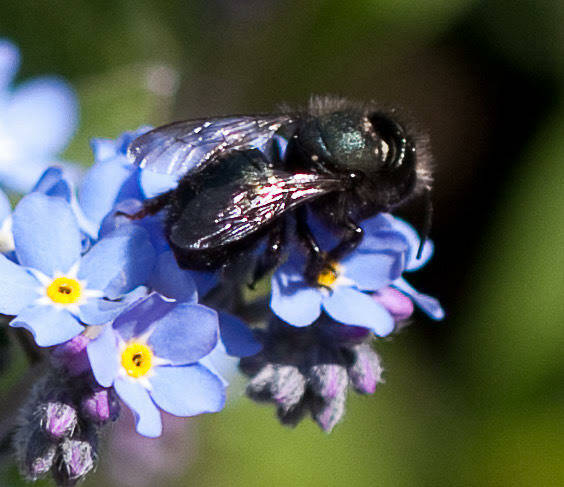Pollination is necessary for gardens to flourish. By some accounts, 75 percent of food production requires pollination. Birds, butterflies, insects, and even the wind work to pollinate plants. One native pollinator, the orchard mason bee (OMB), is an asset to any garden.
Orchard mason bees are native to western Washington climate and plant varieties growing in our area. It is quite possible that you already have OMBs working in your garden. Mason bees are efficient, gentle and easy to accommodate.
These bees are not aggressive, do not make honey, and are purportedly seven times more efficient than honeybees for pollinating fruit trees.
Mason bees are black or bluish-black and two-thirds the size of honey bees. They can be mistaken for other species because their scopa, or body hair on legs, belly and brow, may be laden with golden pollen. Some research indicates that static electricity from the bees’ rapidly flapping wings enables pollen to adhere to the scopa.
Mason bees (Osmia lignaria) are called solitary bees because they nest in preexisting tunnels or holes, rather than in hives. Mason bees are gregarious and will live in a variety of nesting houses near other mason bees.
Reports of colony collapse disease in honeybee hives support reasons to increase diversity among all pollinators.
Avoid pesticides or other toxic spray on trees or nesting areas.
Mason bees are among the first insect pollinators to emerge at winter’s end. When spring temperatures reach 50 degrees and blossoms open on fruit trees and bushes, mason bees emerge from their nests.
First, the males, smaller than the females, fly out to gather pollen to fortify themselves for mating. Three or four days later, females emerge. Males mate, live 10-15 days, and then die. After mating, every female begins her work gathering pollen and nectar and laying eggs for the “next-gen” of mason bees.
Mason bees range no further than the length of a football field during their lifetime. All the elements they need should be nearby. Mason bees do not drill their own nesting tunnels. They use decaying wood with insect or bird holes, wooden posts with 5/16-inch holes drilled in one side (cribbage board style), or clusters of plastic straw-like tubes or dried reeds.
Nest boxes should be hung “shoulder high,” or about five feet above ground. Mason bees need warmth to emerge — south or southeast facing sites, on the sides of sheds or posts work best.
Blossoms such as fruit trees, blueberry bushes, or japonica andromeda bushes should be nearby.
Mason bees need water and soil to create the “masonry” mud partitions between each egg laid in the nest tunnel. Hence, the name “mason” bees.
During the four to six weeks after mating, each female will lay up to 35 eggs. First, females gather pollen and nectar to mix into a pollen ball, sometimes called a pollen loaf, which she places in the back end of the tunnel.
Then, backing into the tunnel, the female will lay one egg, about 3mm long, on the pollen ball. Next, the female will bring dirt and moisture back to the tunnel, making mud to seal the egg chamber. This process is repeated until the tunnel is full.
Female eggs are laid in the back part of the tunnel, and male eggs are laid in the front. The ratio is about ⅓ females to ⅔ males. When the fruit is set on your trees and the blossoms are gone, the adult females die.
Life inside the nest tunnels continues. Eggs hatch, develop into larvae, then pupae, and transform into adults by September. During this time, they will feast on the pollen loaf prepared by the mother. The new bee will spin a cocoon and hibernate throughout winter, until the temperature and blossoms are ready in spring. Cocoons can winter-over outdoors. Some colder microclimates require sheltering nesting boxes in a garage or shed — making sure that the temperature remains between 0-40 degrees.
Mason bee tunnel nests are well known in the animal world for their delicious, nutritious feast of pollen and eggs. Birds, squirrels, and wasps are known to frequently raid the nests. Mesh screens, large enough to allow mason bees access, but small enough to keep birds and squirrels out, can be secured over the front of the nests.
The first task for this spring is to provide housing options for mason bees. Encouraging existing mason bees to stay or purchasing new mason bee cocoons from garden centers are effective ways to jump-start your pollinator population. Be sure to purchase cocoons that are suited to local climate.
For more information about hosting mason bees, check out the Washington State University website at extension.wsu.edu/snohomish/garden/gardening-resources/bees-and-beekeeping/native-bees.
Bev Hetrick is a certified Master Gardener and tends the Mason Bees at the Woodcock Demonstration Garden in Sequim.


